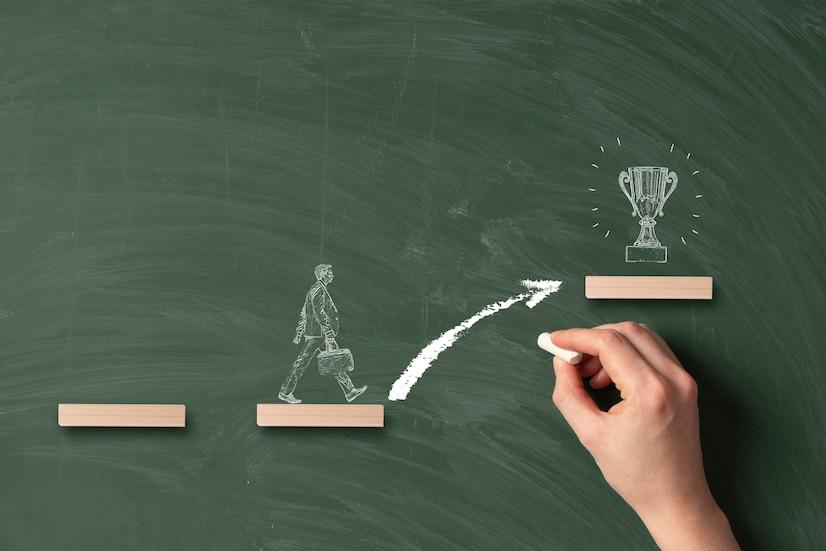
How to escape “starving artist” syndrome and finally learn how to sell
There is perhaps no more judgmental moment in our culture than the five seconds after someone asks you, “So, what do you do?”
Nobody knows this more than artists. An artist is expected to be eccentric, and most importantly, broke. And yet, there are artists that make millions. So how do some artists run thriving businesses, while others languish in obscurity?
Writer Jeff Goins has been obsessed with this question. A writer/entrepreneur himself, he has built a thriving business producing courses like Tribe Writers and writing four books, including the bestselling The Art of Work.
His latest work, Real Artists Don’t Starve, explores why we sabotage ourselves as business owners with hidden scripts about selling being sleazy and making money being “impure.” And most importantly, how we can overcome it all to finally build a business that we love.
This conversation has been edited for length and clarity.
The “starving artist” mentality manifests itself when people say they don’t want to sell because it’s too “sleazy.” How do you see people get over that hurdle?
Steve Jobs and Jim Henson taught us that you can be creative in business and be rewarded for it. The question is, what value does it have?
When you go back to artists that have been said to have struggled and starved, it turns out they were actually smart business people. As an example, Picasso asked Gertrude Stein to pose for him so he could paint her, for no cost. This is a “starving artist” giving away his work for free. Typical, right?
But who was Gertrude Stein? One of the most well-connected patrons in Paris in the 20th century. And what does she do? She hangs up all of this artwork in her house where every week she has all of the patrons from the art community over all the time. So naturally they start asking “who is this guy?” That’s marketing. But, Picasso did it in his way.
Would anyone call Picasso less of an artist for doing this? You don’t have to sell yourself in a sleazy way, in a way that contradicts your values. You DO have to put your work out there. But you get to do this your way.

More than any other industry, artists have this bias that they can’t charge for their work. What can we learn from those who have gotten over this fear?
The thing that so many people struggle with is charging what they’re worth. A friend of mine is an artist and she sold her first ever print to her friend for $20, and it was a struggle. The artist initially offered to give it to her friend for free, and it took her friend to say, “No, I’m paying. This is worth something.” They haggled back and forth and decided that the artist should charge for it like it’s something at Target. It wasn’t much, but it was a start.
Creative business people, the smart ones, they dance with the market. Start somewhere that isn’t zero. Then you can tweak and raise your prices over time. All you have to do is set a precedent that your work is worth something. You can always increase your value, but if you don’t take yourself seriously, no one else will.
How does someone “dance with the market?”
Ask yourself three questions.
1 – What do I want to make off of this?
2 – What are other people charging for something similar? When I went to create my first online course, I realized I never bought a course. I realized I wanted to sell a $99 course and I needed to see what stuff at this level looks and feels like.
3 – What are people willing to pay? You need an audience, an email list. You need to ask potential customers what they would pay. Hopefully before you create it. But you don’t know what someone will pay you until they actually do it. They’ll often tell you what you want to hear or lowball you.
“Dancing with the market” means we have to be adaptable. How do we balance adaptability with grit and determination? Where’s the line?
Learn how to harness your stubbornness. The thriving artists are stubborn about the right things. But the starving artist is stubborn about everything. Jeff Bezos likes to say, “We’re stubborn on vision, but flexible on details.”
I hear people say all the time that “If this isn’t successful, I don’t know what I’ll do.” If you think this, you’re in trouble. Because failure might happen. The most successful people I know have failed, but what got them through wasn’t tenacity to do what wasn’t working over and over again. It was the ability to adapt with feedback.
And yet, we know people that are launching something new every three months. When you are facing failure you look for a single savior. But there isn’t one. It’s gradual tweaks.
Oftentimes we see entrepreneurs that dismiss the success stories of others because they believe the successful person has some advantage they don’t. How do you combat this kind of pessimism?
If you don’t think it will work, it won’t. And if you’ve made up your mind that you’ll never believe me when I say starting your own business is possible, I can’t change it. This is why I think being a starving artist is a choice. You have to tackle your mindset. Ask yourself: Do you even believe it’s possible?
How have you seen this manifest when it comes to selling?
If you decide you can’t make more than $10/hour, you’ll be surprised when you talk to someone who makes $10,000 a project in the same field. Don’t look for 99 reasons to fail, look for the 1 reason to succeed. This is an important decision. I can always blame the fact that I don’t live in a certain place or know certain people. Look at success stories. Look at patterns. Look at what’s possible not just for one person. But the thousands of others.
People dumber than you have done this. But you have to decide you want it and that it’s possible. Don’t “fake it until you make it.” But have faith.
Right. But there’s survivor bias. What about all the people who believed it and still failed?
Typically that means you’re looking for the magic bullet. The “one thing” that you do. My last book was a bestseller and everyone asked me the one thing I did to make it a success. My answer? “Lots of things.” That’s the key to success.
If I want to be healthy, I look at what healthy people do. There’s variance. Genetics, lifestyle, work situation, and other things. But what’s the 80/20 of this? What do most of them do? Most eat a lot of protein, lots of vegetables, and they all move around a lot. They all sleep and drink as much water as possible. These are not hardcore world-changing ideas.
The more things you add to your portfolio from the success bin the better your business will be. It’s a body of work, a portfolio. It’s not one trick or one hack.
What’s something that makes you mad when it comes to the conversation around entrepreneurship?
The probability that you’re going to starve as an entrepreneur is no greater than if you were a plumber or electrician. And yet, we still see stories about this. Where does this bias come from?
In Livorno, Italy, there’s a story about an artist Modigliani in the early 1900s who carves these sculptures and… they weren’t any good. So he throws them into the nearby Medici Canal. In the 1980s to gin up tourism interest, the town decides to drain the canal and see if they can find the statues. They empty the water and find three of them.
Everybody’s ecstatic and all these historians come from all over and say “this is legit!” A few days later these college kids come forward and say “We did this. It’s a prank.” No one believes them. So they go on national TV and recreate a statue with a Black and Decker drill. And people still don’t believe them.
It eventually took weeks for everyone to come around. People couldn’t believe they got it wrong. Sometimes we’d rather believe a beautiful lie than a difficult truth. The story of the starving entrepreneur that’s doomed to fail is a beautiful lie.



